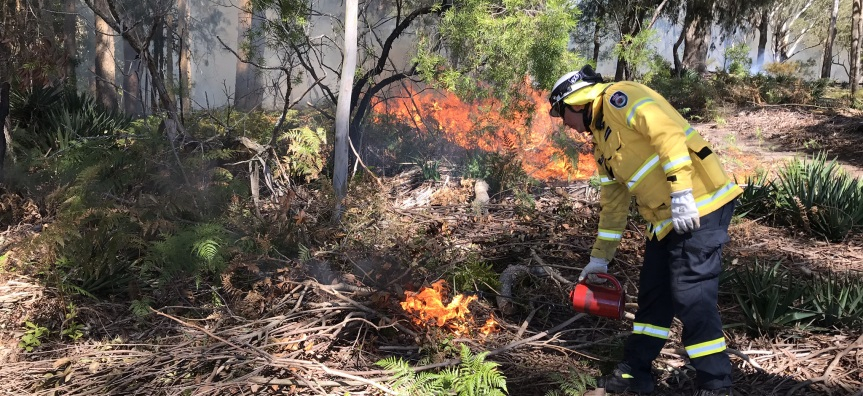
The lead agency for response to bush fire is NSW Rural Fire Service (RFS) and Fire & Rescue NSW (in urban areas).
Fire is a natural part of the Australian environment. With lightning and Indigenous burning methods having shaped natural environment ecosystems over thousands of years, many of our plants are reliant on bush fire to regenerate and stay healthy.
The direction that a landscape faces can affect how a fire moves. On the Northern Beaches, west-facing slopes are the hottest and driest. The vegetation is more flammable, but these plants are more fire tolerant. South-facing slopes are usually cooler, wetter and have less flammable vegetation.
No matter whether you live, work or travel to the Northen Beaches, the below outlines some of the key steps that you can take today to live with and become more resilient to bush fire. In addition, the RFS can help with more specific advice regarding how to plan and prepare including what to do before, during and after a bush fire, as well as the latest bush fire alerts and warnings.
Know your risk
You don't have to live right near the bush to be at risk. Even if your home is a few streets back, you may be at risk. Think about the area you live in and visit the RFS website to know what to expect.
You can check if your property is in a bush fire prone area on the hazards map.
Specific bush fire risk information is available within the Northern Beaches Bush Fire Risk Management Plan.
Bush fire inspections
If you are concerned about a potential bush fire hazard on private or public property, you can contact the RFS Northern Beaches District office by calling 9450 3000, emailing or by filling out a bush fire hazard report online. Once you raise a request, the RFS will complete a site visit and determine if bush fire hazard exists and works are required to reduce the hazard.
Have a plan
Prepare your Bush Fire Survival Plan. It will help you plan what to do including when to leave early and how to prepare your home.
Reduce your risk and prepare your home
Reducing bush fire hazards around your property will lower your risk. A well prepared home is more likely to survive a bush fire.
- Prepare your home and tick off the checklist to be sure you’re ready.
- Reduce bush fire hazards around your property including maintaining an Asset Protection Zone (APZ).
- You may already be required to maintain an APZ through conditions of Development Consent.
- You may be able to create an APZ if the 10/50 Vegetation Scheme applies to your property or if you apply for a Bush Fire Hazard Reduction Certificate (which also includes approvals for other types of bush fire hazard reduction works).
- Prepare yourself and family
- Prepare for your pets and large animals
- Make sure all your important documents are in a safe, easy to access location.
- Check your insurance. Do you have adequate cover for home and contents?
Increase your home's resilience rating
Looking to understand how resilient your home might be from bush fire? The Resilient Building Council's Bushfire Resilience Rating Home Self-Assessment App will walk you through a full assessment of your home and importantly, develop a summary of what you can do to reduce the risk of damage from bush fire. The app provides you with a customised action plan, specific to your individual property and local risk, and updates your home’s Resilience Rating as you take steps to reduce the risk to one of your most important assets.
Know the bush fire alert levels and keep up to date
No matter if you live or work near, travelling through, or planning on spending leisure time within bushland areas on the Northern Beaches, always know the bush fire alert levels and keep up to date of the latest conditions and bush fire information. The below links provide important information.
Get bush fire ready - 5 steps video
During a bush fire or when a fire weather warning is issued
- Activate your Bush Fire Survival Plan.
- Always inform family and friends of your movements.
- Check the RFS alert level of threat from fire.
- Monitor the location and status of Fires Near Me.
- Tune into ABC Radio 702AM to listen to warnings and advice.
- Follow any advice or directions given by the emergency services.
- Neighbourhood Safer Places are a place of last resort during a bush fire emergency. They are to be used when all other options in your bush fire survival plan can't be put into action safely.
- Also, and only if it is safe to do so, contact your ABC Radio 702AM via phone or social media to tell others what you can see. This will help the community with first-hand and reliable knowledge about what's going on.
After a bush fire
- There are many issues to consider after a bush fire, including contacting fire emergency services, getting information and updates about your property, assessing property damage and insurance, understanding the status of your local utilities including electricity, water etc.
- There are a number of assistance schemes available to those in areas declared natural disasters, including personal hardship, assistance for small business and assistance for local councils. Resilience NSW has further information about disaster assistance programs.
